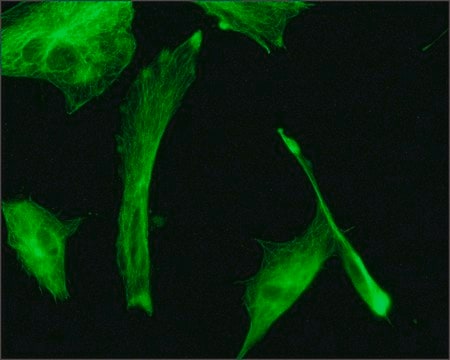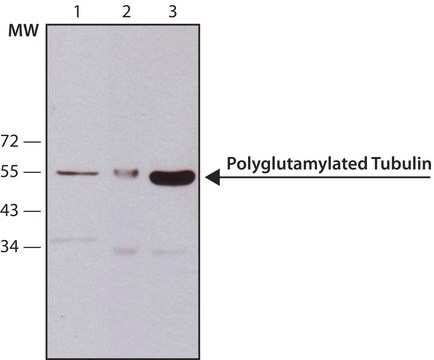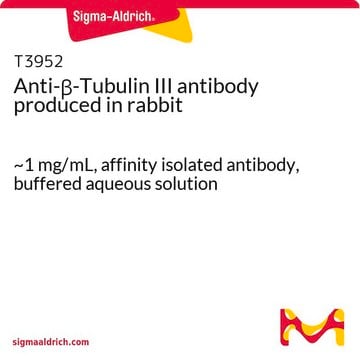T0198
Anti-β-Tubulin antibody, Mouse monoclonal
clone D66, purified from hybridoma cell culture
Synonym(e):
Anti-Tubulin beta-1 chain
About This Item
Empfohlene Produkte
Biologische Quelle
mouse
Qualitätsniveau
Konjugat
unconjugated
Antikörperform
purified immunoglobulin
Antikörper-Produkttyp
primary antibodies
Klon
D66, monoclonal
Form
buffered aqueous solution
Mol-Gew.
antigen ~50 kDa
Speziesreaktivität
human, bovine, chicken, rat, canine, Chlamydomonas reinhardtii, sea urchin (Lytechinus pictus and Paracentrotus lividus), mouse, hamster, Oxyrrhis marina (dinoflagellate), rabbit, monkey
Verpackung
antibody small pack of 25 μL
Konzentration
~1 mg/mL
Methode(n)
immunocytochemistry: suitable (3% paraformaldehyde-0.5% Triton X-100 and methanol-acetone)
immunoprecipitation (IP): suitable
indirect ELISA: suitable
western blot: 0.5-1.0 μg/mL using whole extract of cultured rat adrenal pheochromocytoma (PC-12) cells
Isotyp
IgG1
UniProt-Hinterlegungsnummer
Versandbedingung
dry ice
Lagertemp.
−20°C
Posttranslationale Modifikation Target
unmodified
Angaben zum Gen
human ... TUBB1(81027) , TUBB2A(7280) , TUBB2C(10383)
mouse ... Tubb1(545486) , Tubb2a(22151) , Tubb2c(227613)
rat ... Tubb2(29212) , Tubb2c(296554)
Allgemeine Beschreibung
Spezifität
Immunogen
Anwendung
Biochem./physiol. Wirkung
Physikalische Form
Haftungsausschluss
Not finding the right product?
Try our Produkt-Auswahlhilfe.
Empfehlung
Lagerklassenschlüssel
10 - Combustible liquids
WGK
WGK 3
Flammpunkt (°F)
Not applicable
Flammpunkt (°C)
Not applicable
Analysenzertifikate (COA)
Suchen Sie nach Analysenzertifikate (COA), indem Sie die Lot-/Chargennummer des Produkts eingeben. Lot- und Chargennummern sind auf dem Produktetikett hinter den Wörtern ‘Lot’ oder ‘Batch’ (Lot oder Charge) zu finden.
Besitzen Sie dieses Produkt bereits?
In der Dokumentenbibliothek finden Sie die Dokumentation zu den Produkten, die Sie kürzlich erworben haben.
Kunden haben sich ebenfalls angesehen
Artikel
Microtubules of the eukaryotic cytoskeleton are composed of a heterodimer of α- and β-tubulin. In addition to α-and β-tubulin, several other tubulins have been identified, bringing the number of distinct tubulin classes to seven.
Unser Team von Wissenschaftlern verfügt über Erfahrung in allen Forschungsbereichen einschließlich Life Science, Materialwissenschaften, chemischer Synthese, Chromatographie, Analytik und vielen mehr..
Setzen Sie sich mit dem technischen Dienst in Verbindung.















